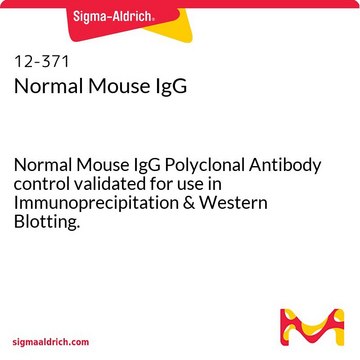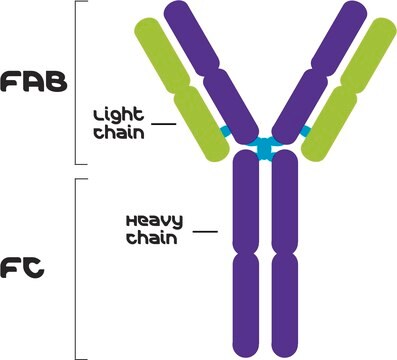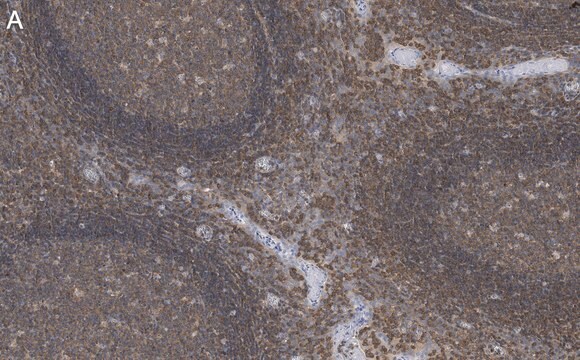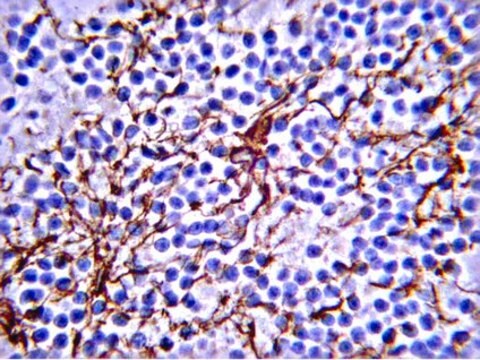CBL610
Mouse IgG1 Negative Control Antibody, clone 1E2.2
clone 1E2.2, 1 mg/mL, Chemicon®
Anmeldenzur Ansicht organisationsspezifischer und vertraglich vereinbarter Preise
Alle Fotos(1)
About This Item
UNSPSC-Code:
12352203
eCl@ss:
32160702
NACRES:
NA.42
Empfohlene Produkte
Biologische Quelle
mouse
Qualitätsniveau
Antikörperform
purified immunoglobulin
Klon
1E2.2, monoclonal
Hersteller/Markenname
Chemicon®
Konzentration
1 mg/mL
Methode(n)
flow cytometry: suitable
Isotyp
IgG1κ
Versandbedingung
wet ice
Posttranslationale Modifikation Target
unmodified
Allgemeine Beschreibung
Immunoglobulin G (IgG), is one of the most abundant proteins in human serum with normal levels between 8-17 mg/mL in adult blood. IgG is important for our defense against microorganisms and the molecules are produced by B lymphocytes as a part of our adaptive immune response. The IgG molecule has two separate functions; to bind to the pathogen that elicited the response and to recruit other cells and molecules to destroy the antigen. The variability of the IgG pool is generated by somatic recombination and the number of specificities in an individual at a given time point is estimated to be 1011 variants.
Spezifität
This isotype control shows negligible cross-reactivity with human cell surface antigens on tissue sections or in cellular preparations. It therefore enables the estimation of non-specific binding of mouse monoclonals to cell surface antigens.
Anwendung
Research Category
Sekundär- & Kontrollantikörper
Sekundär- & Kontrollantikörper
Research Sub Category
Epitop-Tags
Epitop-Tags
Mouse IgG1 Negative Control Monoclonal Antibody validated for use in Flow Cytometry.
Qualität
Evaluated by Flow Cytometry in HeLa cells.
Flow Cytometry Analysis: 2 µg of this antibody was used as a Mouse IgG1 Negative Control in staining of HeLa cells.
Flow Cytometry Analysis: 2 µg of this antibody was used as a Mouse IgG1 Negative Control in staining of HeLa cells.
Verlinkung
Replaces: CBL600
Physikalische Form
Protein G
Format: Purified
Purified mouse monoclonal IgG1κ in buffer containing 0.1 M Tris-Glycine (pH 7.4), 150 mM NaCl with 0.05% sodium azide.
Lagerung und Haltbarkeit
Stable for 1 year at 2-8°C from date of receipt.
Hinweis zur Analyse
Control
HeLa cells
HeLa cells
Rechtliche Hinweise
CHEMICON is a registered trademark of Merck KGaA, Darmstadt, Germany
Haftungsausschluss
Minimum order quantity required to qualify. Unless otherwise stated in our catalog or other company documentation accompanying the product(s), our products are intended for research use only and are not to be used for any other purpose, which includes but is not limited to, unauthorized commercial uses, in vitro diagnostic uses, ex vivo or in vivo therapeutic uses or any type of consumption or application to humans or animals.
Lagerklassenschlüssel
12 - Non Combustible Liquids
WGK
WGK 1
Flammpunkt (°F)
Not applicable
Flammpunkt (°C)
Not applicable
Analysenzertifikate (COA)
Suchen Sie nach Analysenzertifikate (COA), indem Sie die Lot-/Chargennummer des Produkts eingeben. Lot- und Chargennummern sind auf dem Produktetikett hinter den Wörtern ‘Lot’ oder ‘Batch’ (Lot oder Charge) zu finden.
Besitzen Sie dieses Produkt bereits?
In der Dokumentenbibliothek finden Sie die Dokumentation zu den Produkten, die Sie kürzlich erworben haben.
Kunden haben sich ebenfalls angesehen
Paul D Madge et al.
Scientific reports, 6, 36012-36012 (2016-11-04)
Siglec-2 undergoes constitutive endocytosis and is a drug target for autoimmune diseases and B cell-derived malignancies, including hairy cell leukaemia, marginal zone lymphoma, chronic lymphocytic leukaemia and non-Hodgkin's lymphoma (NHL). An alternative to current antibody-based therapies is the use of
Tianfu Wang et al.
Cell death & disease, 11(7), 598-598 (2020-08-01)
Osteoarthritis (OA) is a joint disease that causes great pain to patients and imposes a tremendous burden on the world's medical resources. Regulatory noncoding RNAs, including circular RNAs (circRNAs) and microRNAs (miRNAs), play an important role in OA progression. Here
Tiffany R Frey et al.
Journal of virology, 94(7) (2020-01-17)
Lytic activation from latency is a key transition point in the life cycle of herpesviruses. Epstein-Barr virus (EBV) is a human herpesvirus that can cause lymphomas, epithelial cancers, and other diseases, most of which require the lytic cycle. While the
Tiffany R Frey et al.
Frontiers in microbiology, 12, 708404-708404 (2021-08-27)
Human gammaherpesviruses Epstein-Barr virus (EBV) and Kaposi's sarcoma-associated herpesvirus (KSHV) persist as life-long infections alternating between latency and lytic replication. Human endogenous retroviruses (HERVs), via integration into the host genome, represent genetic remnants of ancient retroviral infections. Both show similar
Florian Bellutti et al.
Journal of virology, 89(3), 1608-1627 (2014-11-21)
Adenoviruses encode a set of highly abundant microRNAs (mivaRNAs), which are generated by Dicer-mediated cleavage of the larger noncoding virus-associated RNAs (VA RNAs) I and II. We performed deep RNA sequencing to thoroughly investigate the relative abundance of individual single
Unser Team von Wissenschaftlern verfügt über Erfahrung in allen Forschungsbereichen einschließlich Life Science, Materialwissenschaften, chemischer Synthese, Chromatographie, Analytik und vielen mehr..
Setzen Sie sich mit dem technischen Dienst in Verbindung.









